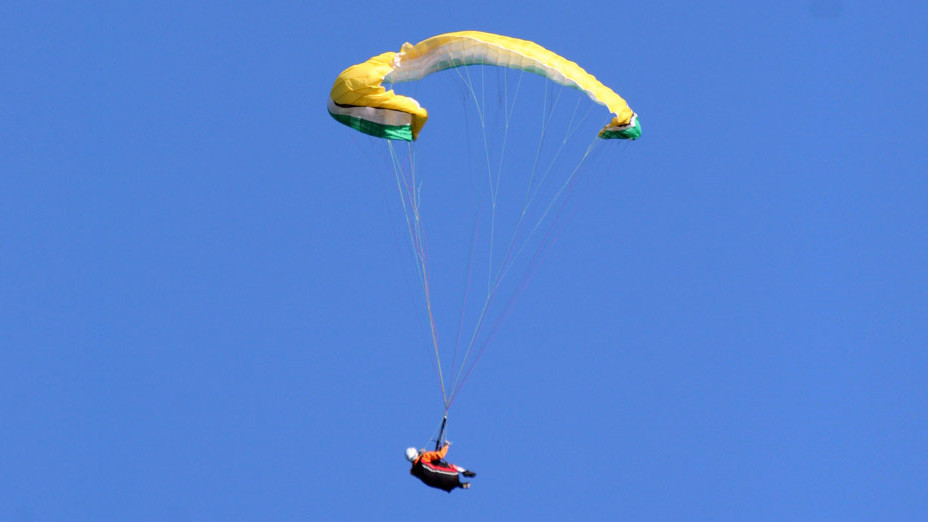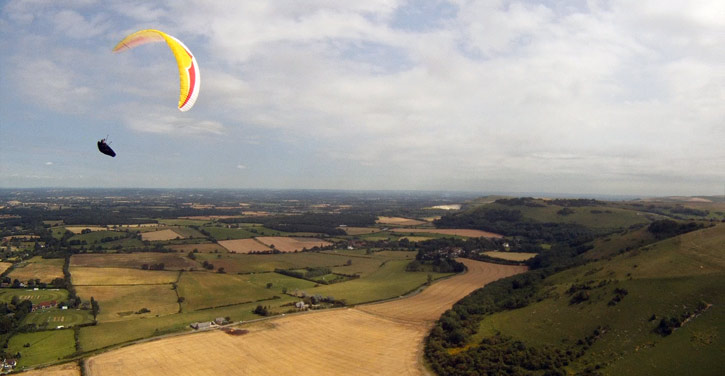
By virtue of his role, Joe Schofield, the editor of BHPA Skywings Magazine, gets to hear many free flight pilots' stories. Unfortunately too many of these involve low-airtime paraglider, paramotor and hang glider pilots flying unsuitable equipment, too advanced for them, often with a bad outcome. Even if, by pure dumb luck, the pilot doesn't actually crash, or by chance isn't injured, their confidence takes a knock. They can become disillusioned, afraid of flying and even lose all interest in the sport. In this article Joe shares his thoughts from many years in freeflight and offers some wise words of advice on how to avoid the pitfalls and continue having a great, safe and above all FUN time free flying for many years to come.
In recent weeks the following have been reported: a paraglider pilot with 12 hours airtime turning up on an SIV course with a top-end B glider, said to have been sold to him by his school (not in this country); a paraglider pilot with 20 hours flying an EN C wing with a pod harness; and a novice paraglider pilot with four hours airtime and an EN A paraglider, who had also just qualified on paramotors and bought an EN C paramotor wing.
Also reported recently: a hang glider pilot trading up to a very high performance topless hang glider at 20 hours; a pilot flying less than ten hours a year trading up to a World Championship level hang glider; and a beginner hang glider pilot who bought a British Nationals pilot's hot ship and crashed it - when rebuilt an experienced test pilot found it so stiff as to be almost unflyable. The list goes on … and on.
What's wrong with this picture? Should we care if pilots pursue their own private follies? I believe we should, because so many of these glider-too-far pilots very quickly lose all interest in the sport. Keen, bushy-tailed improvers become disillusioned almost overnight. A glider they can't handle except perhaps in really benign conditions becomes a liability. They rapidly become afraid of flying in traffic, afraid of scratching, afraid of flying in turbulence, afraid of landing out and, pretty soon, afraid of flying at all.

^ A competition wing: high aspect, high performance, high risk (unless you're a Skygod?)
These unwise purchases are often aided and abetted by doubtful advice from experienced pilots. I have heard old hands tell beginners that they survived buying a high performance paraglider at ten hours and there's no reason the newbie shouldn't, and that an old topless hang glider is an ideal first wing - indeed, many topless pilots seem to believe that any hang glider with a king-post is rubbish by definition. And many experienced pilots will attest to the hoots of derision heard when they turn up on the hill with an EN A paraglider or an easy-to-fly intermediate hang glider.
The point to remember is that we all came into this sport to have fun. If you're not having fun you are doing something wrong. Simples. Grand old man of the sky Jocky Sanderson said it better: the best pilot is the one having the most fun. Another of Jocky's proverbs is this: ‘It's better to fly a more stable glider at 100% than a higher performance one at 60%.' While still managing to look about 27, Jocky's wisdom is comparable to that of Grand Jedi Master Yoda.
Here's a better story: A chap turns up on the hill to buy a high-performance hang glider. He has his old intermediate glider with him and the hot ship seller asks if he can fly it. Conditions are very light with paragliders scratching just above the ridge. The hot-ship pilot scratches expertly to the other end of the ridge, finds lift and goes straight to cloudbase. He lands, raving about the glider's handling, and tells the owner, ‘Don't buy my glider - you'll hate it!' This is, surprisingly, a true story.

^ An EN B wing goes exploring. The pilot has been flying for fifteen years, but has room for error.
Why it this important? Because the intermediate pilot is still in the sport. But the number of pilots we have lost through trading up too far and/or too soon is huge; I know too many of them myself. Anecdotal evidence also suggests that some of the very best pilots got a lot of flying on an intermediate wing before moving to a less forgiving one. A certain highly respected double world champion - in both hang gliding and paragliding - is famous for doing over 100 hours on a very low performance wing before going on to take the world by storm. To forestall the inevitable knee-jerk naysayers, let me agree that the situation is not always clear cut. Selling a high performance glider to a pilot who has 50 hours but is very current and flies on a large site might be better than selling one to a pilot with 150 hours over 25 years. The dilemma is rarely black and white.
So please, newbies - however tough you are, please don't fall for the Emperor's new clothes. Neither a high-end EN B paraglider nor a cheap topless hang glider are going to turn you into a mile-eating XC pilot without the considerable skills the role requires. And those skills are best acquired safely and without stress on a forgiving, easy-to-fly glider. And please, experienced pilots - giving a low-airtime pilot your old Litespeed/EN C might be the quickest way to get another pilot out of the sport. Maybe every time we repeat this message it does get through to the pilots that matter, and the need to repeat it is simply to educate another new generation of pilots. I sincerely hope so!
Joe Schofield, Editor of BHPA Skywings Magazine

^ Will your wing work against you, or with you?
Greg from Flybubble read Joe's article and wrote to him:
Dear Joe
Your message was timely and cannot be mentioned often enough.
After reading your article, I went to a popular southern site and witnessed a crash caused by a pilot flying a glider too far. He has a few years experience but he spun his EN D wing trying to thermal tightly in crowded conditions. He had enough height to recover, or to throw his reserve, but he did neither. His responses displayed that his skills did not match the class of wing.
If he'd been flying an easy B, the wing would have recovered despite his panicked inputs. Unfortunately he continued to spin and stall the wing until he released it too low and spiralled it into the ground. Luckily he crashed in a very visible position and rescue was swift.
These kinds of incidents make me angry because they are so unnecessary and they cause pain, sadness and fear. An EN D wing is meant for pilots with 100s of hours experience and requires regular SIV practice to maintain a base level of aerobatic recovery responses.
Old EN D wings are the cheapest you can get, often 'free to a good home'. Don't be fooled, it's cheaper to buy the right wing for your skills, because even a minor accident can cost you thousands, and as your article suggested, the wrong wing can cost you your love of this amazing sport. Can you put a price on that?
My rule of thumb has always been: fly one class of wing below the class you think you are capable of handling. That way you have a safety margin when you fly into a 'situation'.
Regards
Greg Hamerton, Flybubble
Brought to you by Flybubble
Like what we do? The best way to thank and support us is to buy gear from us and recommend us to others. Review our service on Trustpilot and our products on Flybubble Shop. You can also subscribe to Flybubble Patreon. Thank you!

